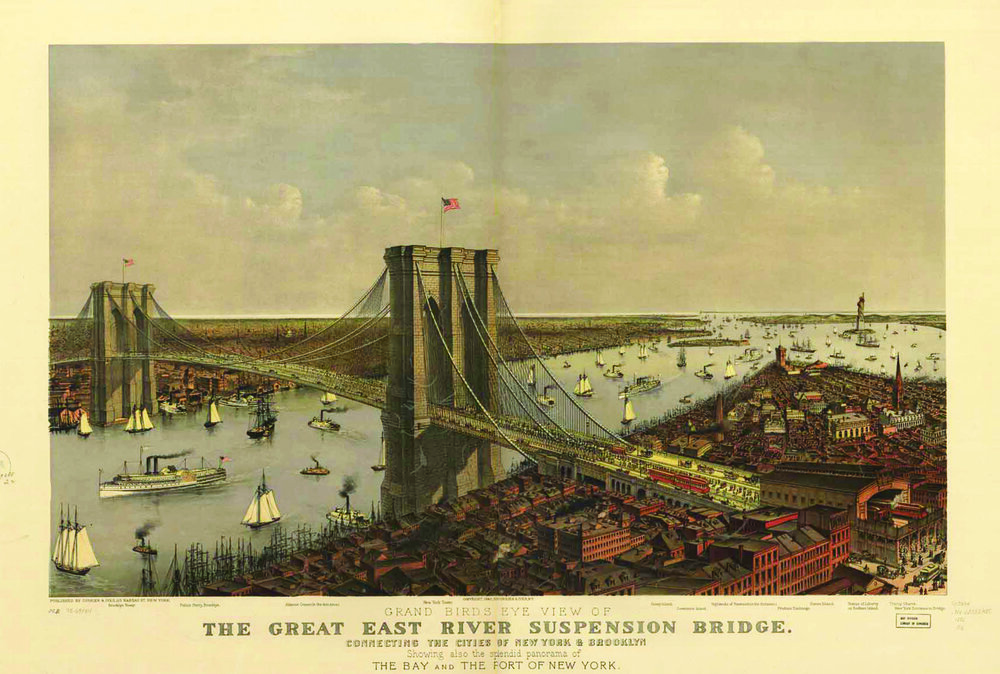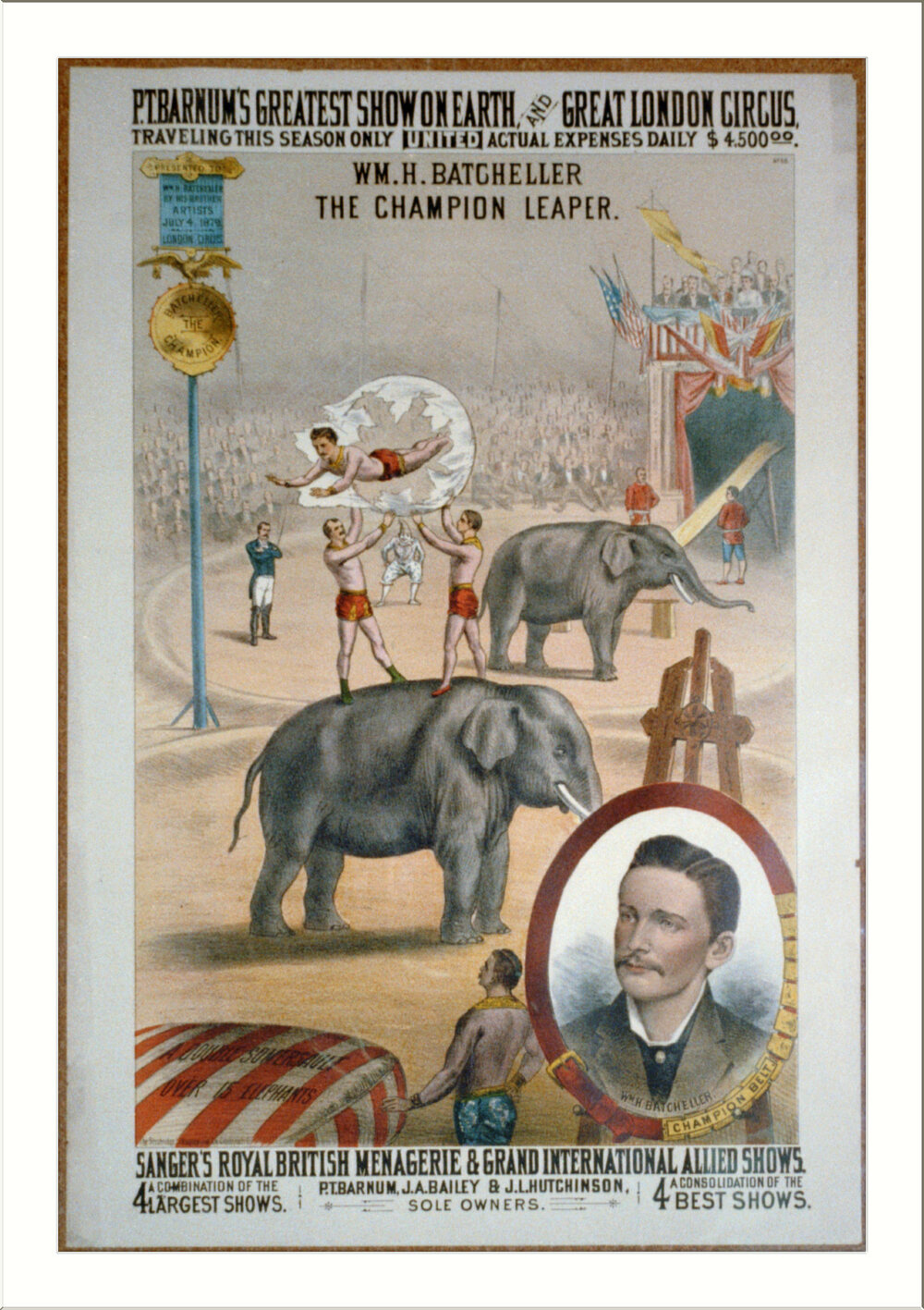Elephants On The Brooklyn Bridge
Posted by Edward Moran on Apr 12th 2020
It was an audacious project from the start. Fourteen years in the building, the Brooklyn Bridge easily catapulted itself into the ranks of the Seven Wonders of the Industrial Age. The Bridge was a triumphal mash-up of Gothic sublimity and engineering know-how; it was a fertile inspiration to preachers, poets, and painters; it was a seductive challenge to daredevils.
The thrusting span, more than a mile long, was also a bumptious reminder of New York City’s emergence as America’s richest and most populous city, for it was the first of several iconic pieces of urban furniture that would forever define “New York” to the world, the others being the Statue of Liberty framed by a backdrop of soaring skyscrapers. Bartholdi’s giantess would raise her beckoning torch across the bay just three years after the Bridge was completed, and within the next score of years, a forest of high-rises would be sprouting like sequoias all over lower Manhattan, just south of where the Bridge made landfall on the island. Though these later buildings are much taller, they are surpassed by the Bridge’s majestic and cathedral-like proportions. It can be argued that the Brooklyn Bridge was the city’s first skyscraper in disguise: its arched pylons rose 276.5 feet, dwarfing most buildings in New York and Brooklyn, except for Richard Upjohn’s Trinity Church, whose spire, also Gothic, bested the Bridge by a scant four and a half feet.
The Bridge also became a vast open-air stage for some of the rollicking excesses of nineteenth-century showmanship. In May 1884, scarcely a year after the Bridge’s opening, P. T. Barnum drove a herd of nineteen circus elephants across the span, led by his legendary Jumbo. The feat was designed to allay public fears about the Bridge’s durability -- not a week after its completion, a panicky crowd, convinced it would collapse, stampeded, leaving twelve dead -- but the stunt was also orchestrated as a shameless promotion for Barnum’s circus.[i] In the days before Jumbatrons, the Brooklyn Bridge thus served as a big screen onto which public-relations shills projected their larger-than-life fantasies. Snake-oil salesmen, too, for the way they tried to sell the Brooklyn Bridge to gullible tourists. Not to forget the daredevils who saw the Bridge as a plaything, like Steve Brodie, whose disputed leap into the East River on July 23, 1886 earned him his 130 years of fame.[ii]
The Brooklyn Bridge also helped jump-start the consolidation of New York City as the nation’s metropole. It acted as an accelerant to the movement, mostly achieved in 1898, to unite Brooklyn, New York, Queens, Staten Island, and The Bronx into Greater New York, the city of five boroughs that we know today. Brooklyn voters agreed to this union by a scant 277 votes, a referendum dubbed the “Great Mistake” by diehards even to this day.[iii]
In a sense, the Brooklyn Bridge was the East Coast’s exuberant answer to what was going on in the also-thriving West in post-Civil War America, when the axis of civic energy shifted from North-South conflict to East-West expansion.. On May 10, 1869, only weeks after construction had begun on the Bridge, the Atlantic and Pacific oceans were finally linked by the opening of the great transcontinental railway that had been in the making for the past three years. A decade or more before Barnum’s elephants proved the Bridge’s durability, vast herds of buffalo were yielding to the onslaught of Irish immigrants, Chinese coolies, and freed slaves who were feverishly laying track across the Great Plains. Just as the railroad now linked the vast reaches of a newly reunited nation, the Brooklyn Bridge was connecting the teeming prairies of Manahatta and Paumanok, Walt Whitman’s fanciful names for Manhattan and Long Island. As the Western frontier was closing, another was opening in New York City, which poet Marianne Moore saw as “the savage’s romance,/accreted where we need the space for commerce.”[iv]
The contract to build what was initially called the East River Bridge had been awarded to master bridge-builder John Augustus Roebling, already renowned as the designer of several important suspension bridges, including a major railroad viaduct spanning the Niagara River near the Falls. On June 28, 1869, just six weeks after the golden spike was driven to complete the railroad in far-off Utah, John Augustus Roebling was seriously injured in an accident at Fulton Ferry while he was surveying the location for his new span’s Manhattan foundations. He died a month later, and the task of completing the Bridge over the next fourteen years fell to his son, Washington Roebling, who himself would be seriously injured a year later, suffering “the bends” while helping extinguish a fire in one of its underwater caissons. For many years, he lived as a semi-invalid in a townhouse within eye-shot of the bridge, at 110 Columbia Heights, from which he monitored the construction with a telescope and communicated with his crews via his wife Emily, now hailed for her indispensable role in seeing the project to its completion at a time when the role of women in Victorian America was severely constricted.
[i] “Dead on the New Bridge: Fatal Crash at the Western Approach,” The New York Times, May 31, 1883. Accessed May 22, 2016.
[ii] “A Leap from the Bridge,” The New York Times, July 24, 1886. Accessed May 22, 2016.
[iii] Tierney, John. “Brooklyn Could Have Been a Contender,” The New York Times Magazine, December 28, 1997. Accessed May 22, 2016.
[iv] Moore, Marianne. “New York,” The Dial, December, 1921.






